Morro Bay is an estuary, a place where fresh water from land meets and mixes with salt water from the ocean. This mixing of salt and fresh water creates a unique environment that provides food, shelter, and breeding grounds for a wide variety of fish species.
This fall, the Estuary Program began a project to monitor fish communities in the bay. The fieldwork was conducted over a two-week period in September, and the work will be repeated in spring 2024.
Different Fish, Different Habitat
Different types of fish prefer different habitats. Some fish can thrive across many habitat types, while others are habitat specialists, meaning that they require a specific type of environment.
The bay pipefish (Syngnathus leptorhynchus) is a great example of a habitat specialist. With their grass-like slender bodies and green coloring, these fish resemble blades of eelgrass. These fish use eelgrass beds as camouflage to hide from predators and as breeding grounds. During our fall sampling effort, our biologists found thriving communities of bay pipefish living within the eelgrass beds.
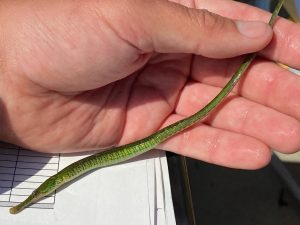
Another habitat specialist in Morro Bay is the speckled sanddab (Citharichthys stigmaeus). This flatfish prefers to lie flat on the bay floor, using their brown and olive coloring to blend into the sand and mud.
The key defining characteristic of a sanddab is the direction of its head. Upon first glance, speckled sanddabs may look like juvenile halibut. Halibut are right-eyed fish, meaning that when they are laid flat, their head and eyes are on the right side of their body. Speckled sanddabs, on the other hand, are left-eyed fish, meaning that when they are laid flat, their head and eyes are on their left side.
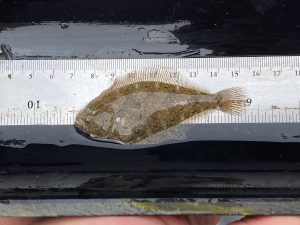
Monitoring Across the Bay
To assess fish communities across the entire estuary, it’s important that we sample all of the major habitat types. These include the deepest waters of the bay, the intertidal zone (the area that is exposed at low tides and submerged at higher tides), and the shallow areas near the shoreline. Each habitat requires a slightly different approach. All sampling is conducted under a permit from the California Department of Fish and Wildlife to ensure that no habitats or species are harmed.
Beach Seining
For areas where we can easily wade into the water, we collect fish using a beach seine. This method involves encircling fish with a large net near the shoreline and then dragging the net and the fish onto the beach. Once on the beach, samplers place the fish into large buckets with oxygen bubbled through them. The fish are identified and measured and then returned to the water unharmed at the same location where they were collected.
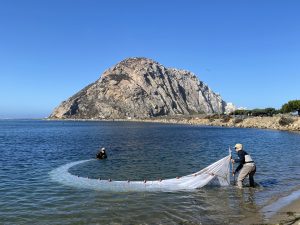
Trawling
However, deeper waters require a different capture method like a trawl. We use a large net pulled by a boat to capture fish which are identified and measured before being returned to the bay’s waters.
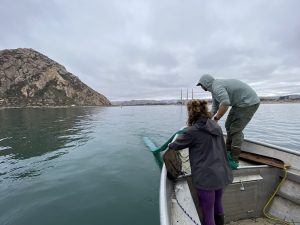
This monitoring was originally conducted in the early 2000s when eelgrass was abundant in Morro Bay. The work was repeated just over a decade later after most of the bay’s eelgrass was lost. Now that eelgrass has reestablished, we are using many of the same methods to determine how fish populations have shifted. By assessing changes over time, we can identify patterns, trends, and potential shifts in the ecosystem.
Comparing DNA
Part of our fish sampling effort includes an environmental DNA (eDNA) component. Organisms in the bay release genetic material into the water through shedding, feces, or decaying tissue. We collect water samples and filter them to concentrate the genetic material. The filters are then sent to a lab for genetic sequencing and analysis to identify the species present. The results from the genetic sequencing will be compared to the physical catch to determine similarities and differences between these two approaches.
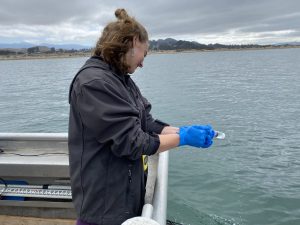
Stay Tuned!
This fish monitoring effort will be repeated in the spring to assess seasonal differences in fish populations. Stay tuned for more information and results on fish in Morro Bay!
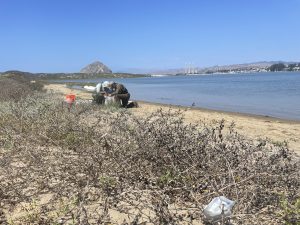
Help us protect and restore the Morro Bay estuary!
- Donate to the Estuary Program today and support our work in the field, the lab, and beyond.
The Estuary Program is a 501(c)3 nonprofit. We depend on funding from grants and generous donors to continue our work. - Support us by purchasing estuary-themed gear from ESTERO. This locally owned and operated company donates 20% of proceeds from its Estuary clothing line and 100% of Estuary decal proceeds to the Estuary Program. Thank you, ESTERO!
- Purchase items from the Estuary Program’s store on Zazzle. Zazzle prints and ships your items, and the Estuary Program receives 10% of the proceeds. Choose from mugs, hats, t-shirts, and even fanny packs (they’re back!) with our fun Estuary Octopus design, our classic Estuary Program logo, or our Mutts for the Bay logo.
Thank you for helping our beautiful, bountiful, biodiverse bay!